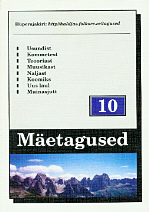Sauna taga tiigi ääres....
At the Pond behind the Sauna (Sauna taga tiigi ääres)
Author(s): Marju Torp-KõivupuuSubject(s): Music
Published by: Eesti Kirjandusmuuseum
Summary/Abstract: The folklorisation process of authorial songs is by no means a remnant of the past. The works of local song composers circulate among wider public independently from their author's will. The modern type of rhymed South-Estonian folk song of the recent years is represented in the works of poets Jaan Pulk, Jan Rahman, Contra (Margus Konnula) and many others. Two South-Estonian authorial songs Haani miis [The Haanja Man] and Sauna taga tiigi ääres [At the Pond behind the Sauna] have been sung all over Estonia since the end of the 19th and the beginning of the 20th century. Today, these two songs are known as folksongs. The first was composed by Jaan Räppo (b. on April 11th, 1880 in Võrumaa - died on April 14th, 1958), also known as a politician and cultural figure in the Ukraine. In 1897 he wrote the verse narrative about a poor man from Kasaritsa while studying at the Võru town school in Estonia. The song Sauna taga tiigi ääres was composed by Hermann Julius Schmalz (b. on April 6th, 1870 in Räpina parish on the border of Võru and Setu region). According to the poet and literate himself he had not attended school for a day in his life; instead, he was educated (among other things in German language) by his mother and governess, also by independent study. As a youth he learned to play several folk music instruments, violin, piano and guitar, he could also read music. In fact, his first publication was a collection of violin pieces (Tartu 1893). In 1896 Schmalz moved to Tartu; in 1879 he founded a Setu men's choir which consisted of 5 members and was known under the name of Tooste Acting and Choral Society. Schmalz was one of the first Estonians to introduce elements of Setu folklore in his creation - living next to the Setu he was particularly fond of their culture. He wrote plays and poems in the Setu tradition and tried to perform them with his own acting group in the whole Estonia. He was also one of the first founders of the folkloric music group not only in South-East Estonia but in the whole country, which also indicates that he was well ahead of his contemporaries. The Estonian village music groups of the end of the 19th and the beginning of the 20th century were characterised by a constantly increasing shattering: on the one hand they performed authentic popular music, on the other hand school and orchestrated music. Several Estonian intellectuals of the peasant class regarded folk music with contempt.
Journal: Mäetagused. Hüperajakiri
- Issue Year: 1999
- Issue No: 10
- Page Range: 106-129
- Page Count: 24
- Language: Estonian

